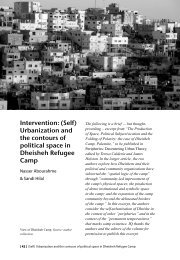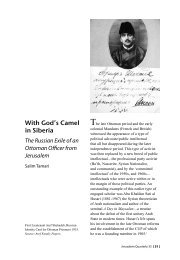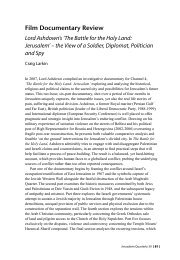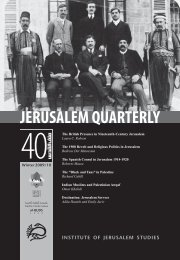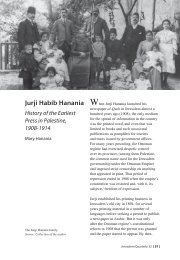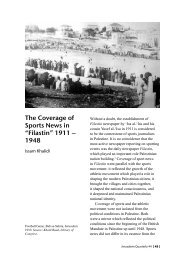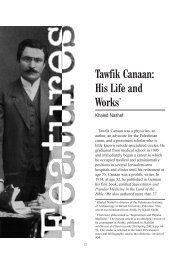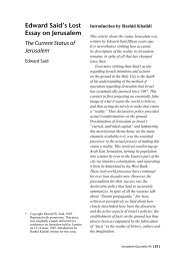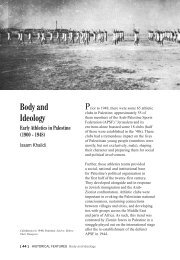PLUNDERING PALESTINE - Jerusalem Quarterly
PLUNDERING PALESTINE - Jerusalem Quarterly
PLUNDERING PALESTINE - Jerusalem Quarterly
You also want an ePaper? Increase the reach of your titles
YUMPU automatically turns print PDFs into web optimized ePapers that Google loves.
the Baptist mosaic is part of a sixth century Byzantine church located in a then-Israeli<br />
military installation in the northwestern tip of the Gaza Strip. It was discovered by<br />
an Israeli archaeologist in 1999. The well-preserved 1461-year-old church measures<br />
13x25 meters, and has three large and colourful mosaics with floral-motifs and<br />
geometric shapes. Nearby is a Byzantine hot bath and artificial fishpond. The most<br />
impressive mosaic is a multi-coloured medallion at the entrance of the church. Its<br />
inscriptions say that the church was called ‘St. John’, after John the Baptist, and its<br />
foundations were laid in 544. It also praises Victor and Yohanan, the mosaic’s donors.<br />
Shortly before the Israeli withdrawal from the Gaza Strip, an Israeli official told<br />
the <strong>Jerusalem</strong> Post, “No decision has been taken yet to remove the mosaic, that<br />
depends on how the dismantling of the military base goes.” He went on, “We will<br />
do everything possible to prevent damage to the antiquities. The mosaics would be<br />
removed to prevent damage; it is something that definitely can be done on the spot.<br />
We will stop the work and remove it if necessary.” 20<br />
Muin Sadeq, director general of the Department of Antiquities in Gaza, told the<br />
<strong>Jerusalem</strong> Post that Palestinians’ concerns also stemmed from the 1974 removal by<br />
the Israel Antiquity Authority of a sixth century Byzantine mosaic, called “King David<br />
Playing the Lyre,” from Gaza City. The artefact now decorates the synagogue section<br />
of the Israel Museum. Hizmi, deputy director of the Israeli Department of Antiquities<br />
in the West Bank, maintained that the removal of the first mosaic was done to preserve<br />
it, adding, “Maybe there was an intention then to return it, but it didn’t work out! I<br />
don’t know why.” 21<br />
In the end, Israeli authorities did not remove the mosaic, but the continued unrest and<br />
instability in the Gaza Strip has Palestinian archaeologists worried about the wellbeing<br />
of the mosaic. Palestinians recognize that looting is a major problem in the<br />
Palestinian areas, and relate it to the total collapse of the Palestinian security system,<br />
which Israel helped generate through its military attacks. Palestinians are demanding<br />
the return of all archaeological finds that Israel excavated and transferred beyond<br />
the 1967 lines, as well as <strong>Jerusalem</strong>’s Rockefeller Museum, which was established<br />
during the British Mandate and called the Palestine Museum, and the objects that were<br />
removed from that museum and taken to the Israel Museum in West <strong>Jerusalem</strong> and<br />
other museums and collections in Israel.<br />
Conclusion: Preventing More Pillage<br />
Negotiations over archaeological issues took place as part of the Oslo Accords and<br />
are supposed to be part of the final status agreement between the two parties. Like<br />
all outstanding issues, the positions of Palestinians and Israelis on the subject of<br />
<strong>Jerusalem</strong> <strong>Quarterly</strong> 33 [ 53 ]



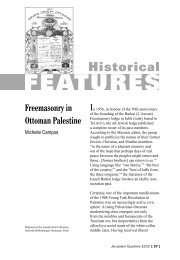
![In Search of Jerusalem Airport [pdf] - Jerusalem Quarterly](https://img.yumpu.com/49007736/1/180x260/in-search-of-jerusalem-airport-pdf-jerusalem-quarterly.jpg?quality=85)
